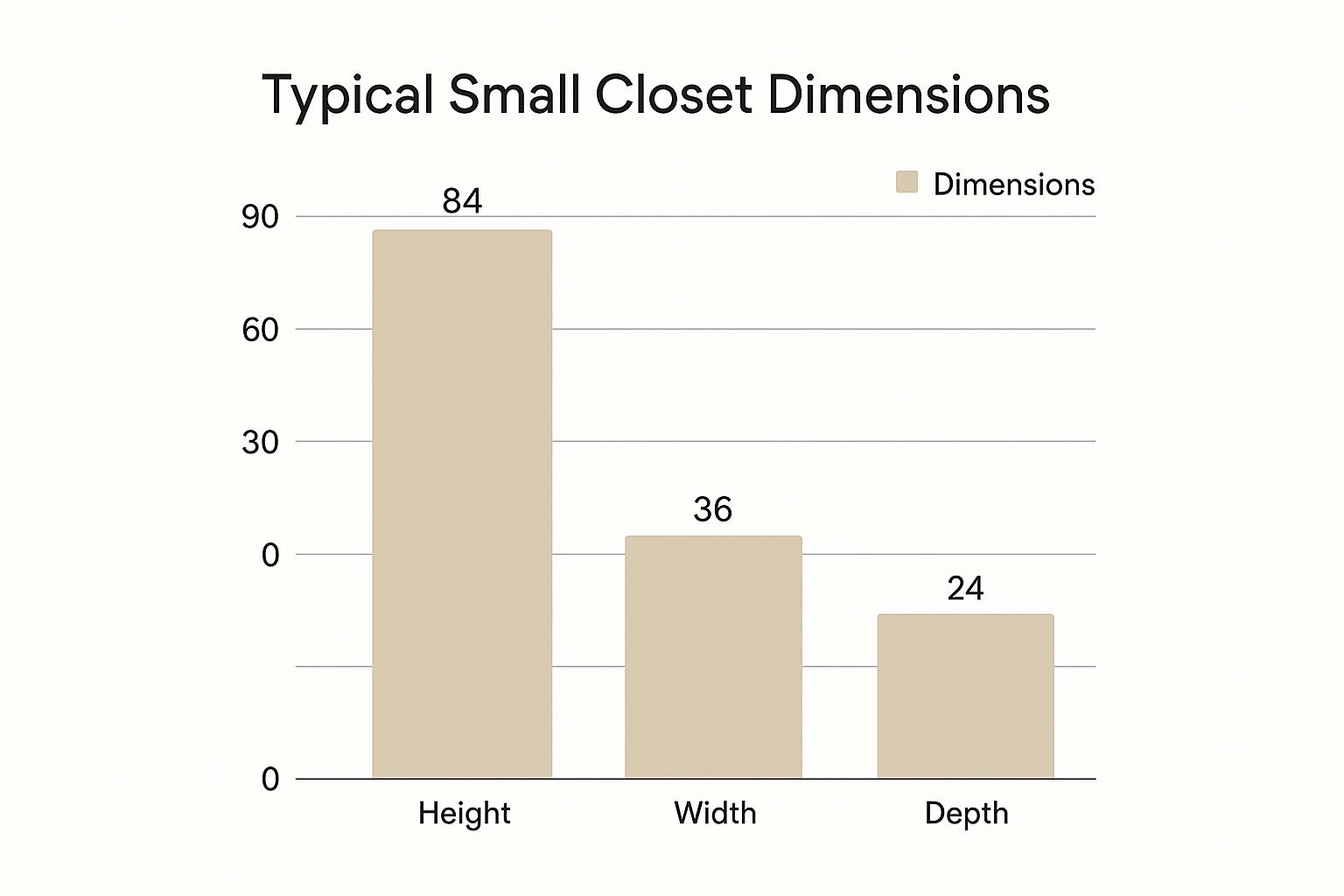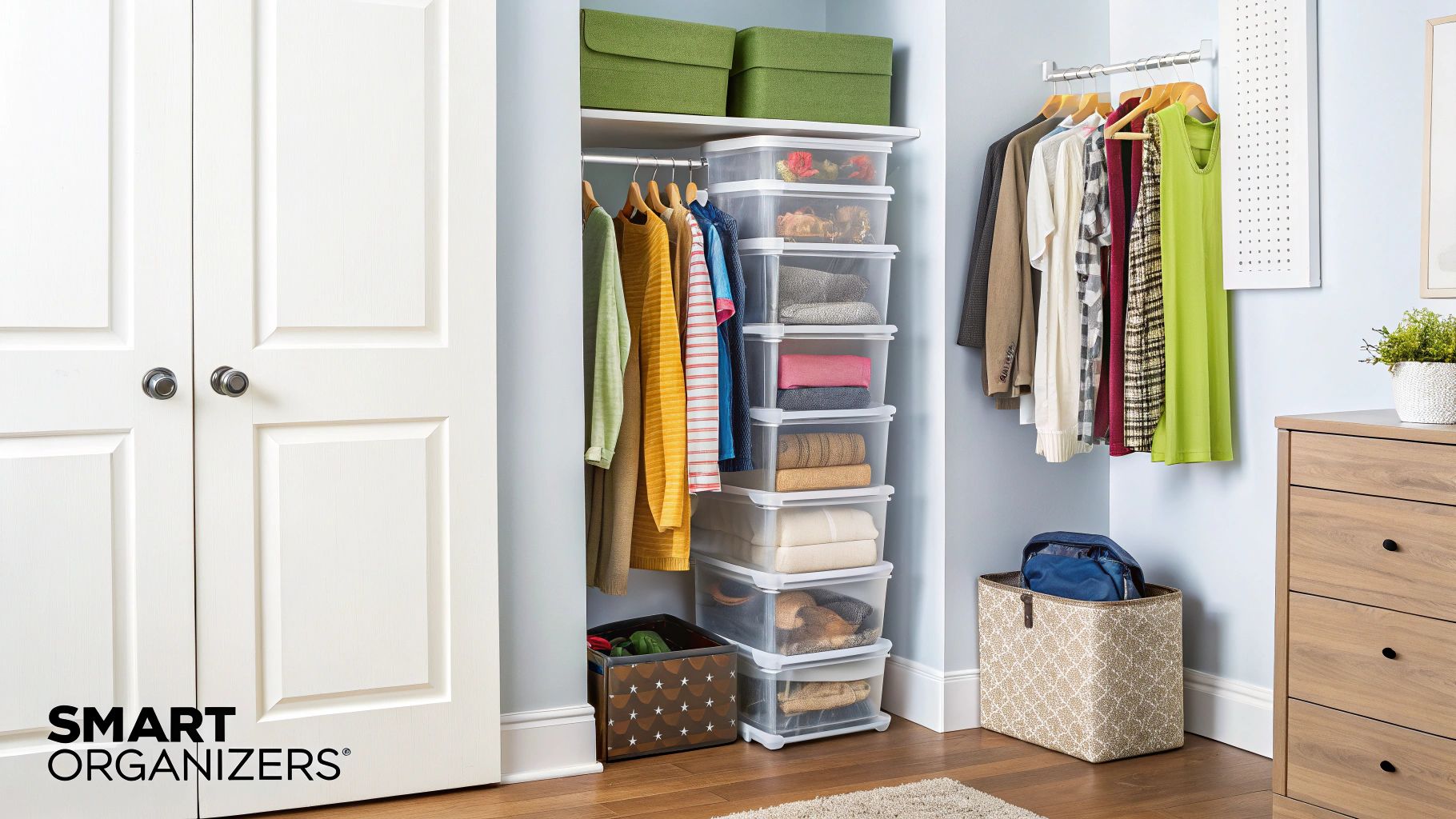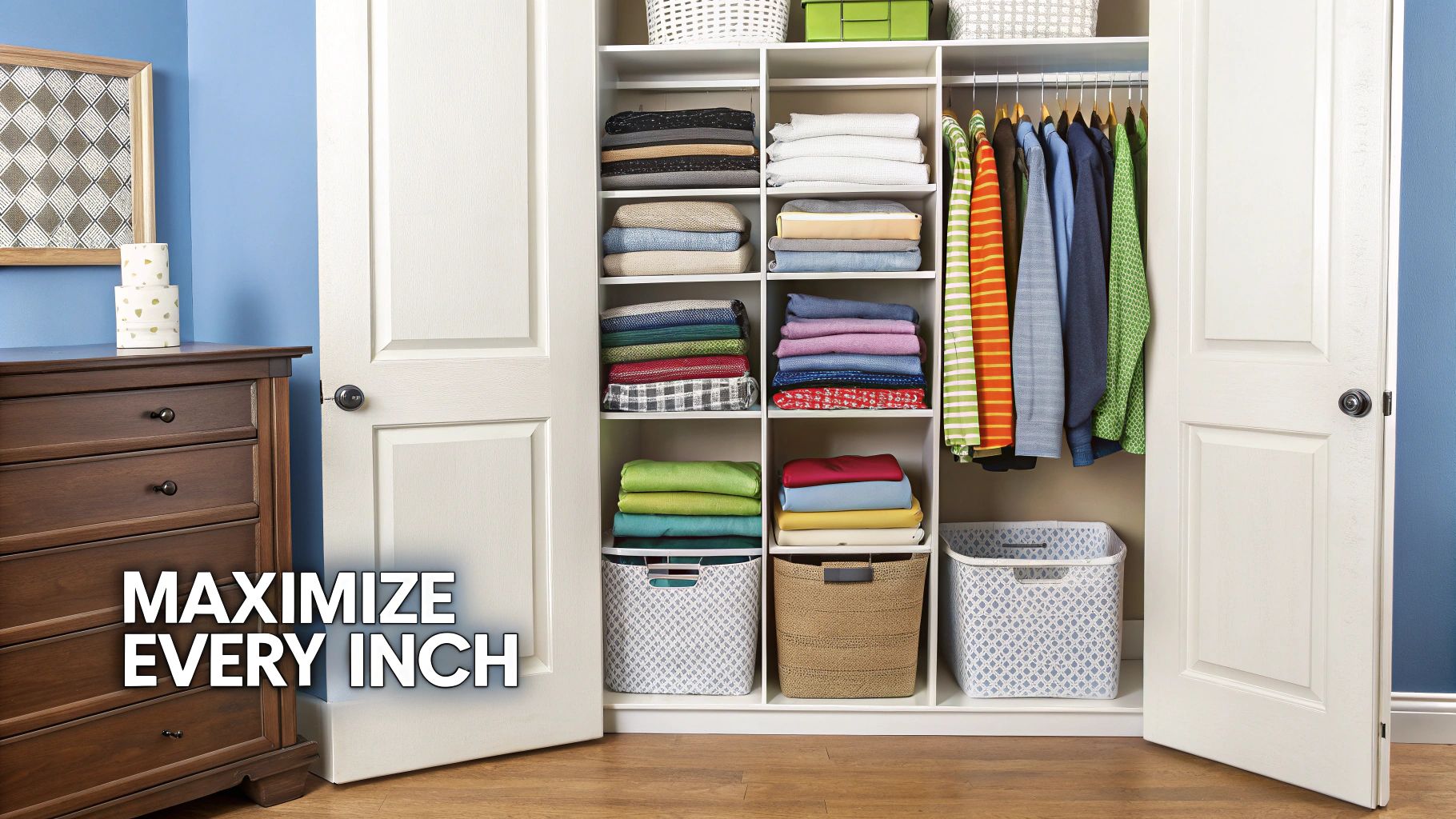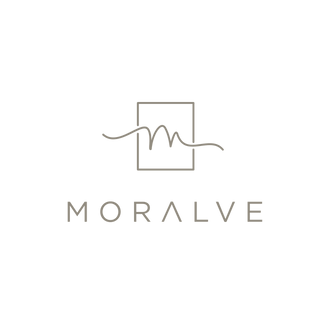Top 10 Best Closet Organizers for Small Closets in 2024

Staring into a cramped, chaotic closet is a frustrating way to start the day. The best closet organizers for small closets are the ones that work smarter, not harder. They maximize vertical space and offer modular flexibility—think stackable drawers and slim-profile hangers that instantly create more room. These clever solutions help you reclaim your space and turn a stressful spot into something functional and calm.
Your Guide to a Clutter-Free Small Closet
This guide is about practical solutions for creating an organized closet. We're going to move past the everyday frustrations of tangled hangers and buried shoes and walk through a straightforward approach to creating order. The secret isn't wishing for more space; it's about using the space you already have more intelligently through effective closet organization.
The whole point is for you to feel empowered and genuinely excited to get organized. We'll dive into how the right tools, especially modular systems from MORALVE, can completely change your daily routine without needing a contractor or a massive budget.
The Growing Need for Smart Organization
The push for a well-organized home isn't just a fleeting trend; it's a response to modern living. As our living spaces, especially in cities, get more compact, the need for efficient storage has exploded. Closet organizers have gone from being a nice-to-have accessory to an essential part of a functional, modern home.
The numbers back this up. The closet organizers market is expected to more than double, jumping from USD 4.03 billion in 2025 to roughly USD 8.53 billion by 2035. This huge growth shows just how many people are investing in making their homes work better for them, driven by a desire for homes that are both functional and visually appealing. You can get more details on this trend over at Future Market Insights.
An organized closet is about so much more than saving space. It's about saving time and cutting down on daily stress. When everything has its own designated spot, your morning routine becomes simpler, and you bring a welcome sense of control to your environment.
What to Expect from This Guide
In the sections ahead, I'll walk you through the entire process of transforming your small closet from a cluttered mess into an organized haven. You’ll learn exactly how to:
- Assess your space to pinpoint its unique challenges and hidden opportunities.
- Choose the best organizers that truly fit your wardrobe and your lifestyle.
- Install your new system with confidence, using our practical, step-by-step guidance.
How to Properly Assess Your Closet Space
It’s tempting to jump right in and start buying bins and organizers, but that’s a classic mistake that hinders effective closet organization. A truly organized closet starts with a plan, and that plan begins with a tape measure.
Before you do anything else, you need to get the hard numbers. Grab a tape measure and jot down the core dimensions of your closet: the height, width, and depth. But don't just stop at the big numbers. Look for the little details that can trip you up later. Is there a sloped ceiling? Note the measurement at both the lowest and highest points. How much clearance do you have around the doorframe? This is critical for knowing how far an organizer can extend before it blocks the door.
Measure Twice, Buy Once
The small details make all the difference in closet organization. For example, many older homes have thick baseboards that can prevent a floor unit from sitting flush against the wall. You have to account for that half-inch. Similarly, take a moment to locate any light switches or outlets inside the closet—you don't want to block access to them.
This infographic gives you a solid baseline for typical small closet dimensions, which can help you see how your own space stacks up.

Knowing whether your closet is unusually deep or exceptionally narrow helps you start thinking about what kind of organizers will work best.
With your measurements in hand, the next step is a quick, honest inventory of your wardrobe. We're not decluttering just yet—that comes later. Right now, the goal is to understand exactly what you need to store. This is the secret to finding the best closet organizers for small closets because it ensures you buy solutions for the clothes you actually own.
Just make a few simple piles. Don't overcomplicate it.
- Hanging Items: All your shirts, dresses, jackets, and trousers. How much rod space are they taking up?
- Folded Items: Think sweaters, t-shirts, and jeans. How high do those stacks get?
- Shoes & Accessories: Do a quick count of your shoes, bags, belts, and scarves.
- Oddballs: Make a note of anything bulky or unusually shaped, like a winter coat or a formal gown you rarely wear.
Think of this as creating a 'closet map.' Your measurements define the borders, and your inventory shows you what needs to fit inside those borders. This map is your guide for the entire closet organization project.
Create Your Personal Closet Map
Now, let's put the two pieces together: your measurements and your inventory. This is where the magic of closet organization begins. For instance, if you realized your closet is tall but has very little hanging space, a vertical organizer or a skinny tower unit becomes an obvious choice. If you're swimming in sweaters, then shelves or stackable drawers should be at the top of your shopping list.
This approach stops you from buying a generic "one-size-fits-all" system that doesn't actually fit your life. Instead, you can pick and choose the exact pieces you need, like MORALVE's specialized hangers and modular components, to solve your unique storage challenges. With a clear map, you’re ready to pick the right tools for the job.
Choosing the Best Organizers for Your Needs
Alright, with your closet measurements and inventory in hand, it's time for the fun part—picking the gear that will transform that chaotic space into an organized one. This is where your plan comes to life. The trick is to avoid just buying "organizers" and instead choose specific tools that solve your unique closet organization problems.
Think about it: a narrow hall closet needs a completely different strategy than a small bedroom closet. The hall closet is usually a drop-zone for coats, boots, and bags, so it needs heavy-duty hooks and slim shoe storage. A bedroom closet, on the other hand, has to handle everything from dresses and suits to t-shirts and accessories, which calls for a more layered approach with hanging space, shelves, and drawers.

Vertical Solutions Are Your Best Friend
When you're working with a small footprint, the only way to go is up. Your closet's height is its biggest untapped resource, and that's where vertical organizers become absolute game-changers for closet organization. They create storage out of thin air.
Here are a few of my go-to vertical heroes:
- Hanging Shelves: These fabric workhorses are brilliant for folded items like chunky sweaters, jeans, or even handbags. They just loop over your existing closet rod, giving you instant shelving with zero installation.
- Slim Hangers: Seriously, this is a non-negotiable for closet organization. Switching from mismatched plastic or thick wooden hangers to a uniform set of slim velvet hangers can free up up to 50% of your rod space. It’s the single fastest way to make a cramped closet feel bigger. We dive deep into this topic in our guide to the best space-saving hangers.
- Clear Stackable Drawers: Perfect for socks, scarves, belts, or rolled t-shirts. Because they're clear, you can see exactly what's inside without pulling everything out. They stack neatly on a shelf or the floor, letting you build a custom "dresser" right inside your closet.
To make it even clearer, let's break down which organizers tackle which closet organization problems.
Matching Organizers to Your Closet Needs
| Organizer Type | Best For | Key Benefit for Small Spaces |
|---|---|---|
| Hanging Shelves | Bulky sweaters, jeans, purses | Creates instant, accessible shelves using vertical space. |
| Slim Velvet Hangers | All hanging clothes (shirts, pants, dresses) | Dramatically increases hanging capacity on the rod. |
| Clear Stackable Drawers | Small accessories, socks, underwear, t-shirts | Contains clutter and allows for easy visibility. |
| Over-the-Door Hooks | Robes, jackets, bags, scarves | Utilizes the often-ignored back of the closet door. |
| Shelf Dividers | Stacks of folded clothes on a shelf | Prevents piles from toppling over and mixing together. |
| Tiered Shoe Racks | All types of footwear | Maximizes floor or shelf space by storing shoes vertically. |
This table is a great starting point, but the real magic happens when you start combining these solutions.
Modularity and Customization
The best closet systems for small spaces are the ones that can adapt as your life and wardrobe change. A rigid, one-size-fits-all setup is a recipe for future frustration. The beauty of modular pieces is that you can create a system that’s perfectly tailored to you right now, and then easily adjust it later.
You might start with just a hanging organizer and a shoe rack. Six months down the line, you can add a set of stackable drawers or a few shelf dividers. This mix-and-match approach ensures every single inch is working for you.
This isn't just a hunch; it's a huge trend in the home organization world.
The market for home organizers in the United States is expected to reach USD 12.05 billion by 2025. A major driver for this growth is the demand for modular, multipurpose systems that are perfect for smaller living spaces. You can see more data on this trend in the full report from Mordor Intelligence.
What this tells us is that people want smart, flexible storage that fits their life. Products like MORALVE’s specialized hangers and organizers are designed with this exact mindset. By choosing components that solve your specific storage headaches, you’re not just tidying up—you’re building a personalized closet organization system that makes your daily routine simpler and less stressful.
Putting It All Together: A Realistic Guide to Installing Your New Closet System
Staring at a pile of flat-packed boxes can be intimidating, I get it. But turning them into a sleek, functional closet system is a project you can absolutely tackle yourself. Think of it as a satisfying weekend challenge—one that even a DIY novice can handle with a little bit of prep work.
The secret to a stress-free installation isn't about being a pro; it's about setting yourself up for success before you even open a box. First thing’s first: completely empty your closet. This is the perfect time to give the walls a quick wipe-down and vacuum the floor. Working with a clean slate makes the closet organization process feel much more manageable.
Your Pre-Installation Checklist
Let's talk tools. Having everything you need within arm's reach saves you from those frustrating mid-project hunts. You don't need a professional workshop, just a few key items.
- A reliable drill: Your best friend for mounting shelves and rods securely.
- A level: Don't even think about skipping this. Eyeballing it is a recipe for wonky shelves.
- A screwdriver: Perfect for manual tightening and those final little adjustments.
- A stud finder and painter's tape: Locating the wooden studs in your wall is the only way to guarantee a truly secure installation. Mark each one you find with a small piece of painter's tape.
Pro Tip: Before you do anything else, unbox all the components and sort the hardware. I like to use small containers or labeled zip-top bags for the different screws, brackets, and dowels. It might seem tedious, but it saves a massive amount of time and prevents that dreaded "where did that one tiny screw go?" panic.
Once your closet is empty and your tools are ready, it's time to start building. Always follow the manufacturer’s instructions, but a good rule of thumb is to assemble any freestanding pieces, like drawer units, out in the room where you have more space to move around.
Mounting Your Organizers for a Secure Fit
This is the moment of truth. A poorly mounted organizer isn’t just an eyesore; it’s a potential safety hazard. That painter’s tape you used to mark the studs? It’s about to become invaluable. Whenever you can, drive your mounting screws directly into a stud for the strongest hold possible.
What if a stud isn't conveniently located right where you need a bracket? You’ll need to use a drywall anchor. These little plastic or metal sleeves expand behind the drywall, creating a surprisingly strong anchor point for your screw. Skipping this step is one of the most common mistakes I see, and it almost always leads to sagging shelves or screws pulling right out of the wall.
With your main components—like shelving units and hanging rods—securely on the wall, you can add the final touches. Slide in the drawers, pop in any shelf dividers, and clip on your accessories. Give everything one last check with your level and make any final tweaks. A rock-solid installation is the foundation of a closet that will serve you well for years.
For a deeper dive into planning your layout from the start, check out our guide on how to design a closet for maximum efficiency.
Smart Techniques to Maximize Every Inch
With your new organizers installed, it's time for the fun part—putting everything back in a way that actually works. This is where we move beyond just "organizing" and start thinking strategically. A few clever habits will turn your newly organized closet into a system that stays tidy and makes your life easier.
This is how you get the most out of your new closet organization setup.

Think of it as setting up your closet for success. A little intentional placement now will save you countless headaches later and stop that dreaded clutter from creeping back in.
Create Zones for Your Life
The single most effective trick for closet organization is to create 'zones.' It's a simple idea, but it's a game-changer. Instead of just lumping all your shirts together, group them by how you actually live your life.
- Workwear: This is your command center for weekday mornings. All your office shirts, slacks, and blazers go here. No more frantic searching before your first cup of coffee.
- Weekend & Casual: Your favorite jeans, comfy tees, and go-to sweaters should live together. When Saturday rolls around, you know exactly where to look.
- Activewear: Keep all your gym and workout gear in one spot. It removes one more excuse for skipping that workout when you can grab what you need and go.
Zoning your closet cuts down on decision fatigue and lets you find what you need in a flash. It’s a small tweak that brings a surprising amount of calm to the morning rush. For more ideas like this, check out our guide on how to make a small closet bigger.
Master the Seasonal Swap and the "One In, One Out" Rule
Let's be honest, a small closet can't hold your entire wardrobe all year round. That's where seasonal rotation is your best friend in closet organization. Those bulky winter coats and heavy sweaters don't need to take up prime real estate in July.
Move off-season items to a less accessible spot—the very top shelf, under the bed, or in a storage bin. This frees up your main closet space for what you're actually wearing right now.
To keep things from getting out of control again, I live by the ‘one in, one out’ rule. Every time you buy a new item, one old item has to go. It’s the simplest, most effective way to prevent your closet from becoming overstuffed.
This shift toward smarter storage isn't just a trend; it's a massive movement. The global closet organizer market was valued at USD 8.31 billion in 2025 and is expected to climb to USD 11.58 billion by 2029. People everywhere, especially in cities with smaller homes, are realizing how much of an impact an organized space can have on their lives. You can find more details on the closet organizer market at ResearchAndMarkets.com.
Use Every Last Nook and Cranny
Finally, it's time to scout for hidden opportunities in your closet organization plan. That empty space on the back of your closet door? It’s perfect for an over-the-door organizer for shoes, belts, or scarves.
Are your folded sweaters always toppling over? Shelf dividers are a brilliant solution to keep those stacks neat and tidy. These small finishing touches are what take your closet from just organized to truly optimized, ensuring no inch of space goes to waste.
Answering Your Top Small Closet Questions
Even with the best game plan, organizing a small closet can bring up a few nagging questions. It's totally normal. Let's tackle some of the most common ones I hear so you can move forward with confidence and build a closet that genuinely makes your life easier.
Getting these last few details sorted out is often what makes the difference between a good closet and a great one.
If I Can Only Buy One Thing, What Should It Be?
This is the big one. If your budget only allows for a single organizer, where do you get the most bang for your buck? Hands down, my answer is always a vertical organizer. This could be a set of hanging fabric shelves that you loop over the rod or even a slim, freestanding tower.
Why? Because these organizers tap into the most neglected real estate in any closet: the empty air above your clothes and below your hems. By turning that dead space into stacked shelves, you can instantly carve out a home for folded sweaters, jeans, or handbags. It’s the quickest, most dramatic way to increase your storage without needing a single tool.
How Do I Make My Tiny Closet Feel Bigger?
Making a small space look bigger is all about tricking the eye and creating a sense of calm. You want to reduce the visual chaos so your brain can relax. I've found a few simple closet organization tricks that work wonders.
- Get Matching Hangers: Seriously, this is non-negotiable. A mishmash of plastic, wire, and wooden hangers looks messy. Switching to a single style of slim hanger creates an immediate sense of order and sophistication.
- Stick to a Light Color Palette: When choosing your organizers, think light and bright. White, beige, or a light natural wood finish will reflect light and keep the space from feeling like a cave.
- Light It Up: Don't underestimate the power of good lighting. You can't use what you can't see! A simple battery-powered, stick-on LED light can illuminate every corner, making the closet feel more expansive and functional.
A visually clean closet isn't just about looking pretty on Instagram. It’s practical. When your eyes aren’t darting between a dozen different colors and shapes, you can spot what you need in a fraction of the time. It’s a simple change that can genuinely improve your morning routine.
How Often Do I Really Need to Declutter This Thing?
In a compact closet, there’s no hiding from clutter. It builds up fast. To keep your newly organized space from slipping back into chaos, consistency is key. I recommend a quick decluttering session twice a year. The perfect time to do this is when you’re switching your clothes over for the new season. It’s a natural moment to re-evaluate what you actually wore.
For the day-to-day, the 'one in, one out' rule is your secret weapon. Every time you bring a new shirt or pair of pants home, an old one has to go. This little habit forces you to be more intentional with your purchases and keeps your closet at a perfect equilibrium. It ensures your organizers are holding things you love and use, not just becoming a storage unit for stuff you've forgotten about.
Ready to stop fighting with your closet and start using smart, space-saving solutions? Check out the full collection of organizers at MORALVE. See for yourself how our innovative hangers can help you reclaim your space and simplify your daily routine. Start organizing today at moralve.com.


Leave a comment